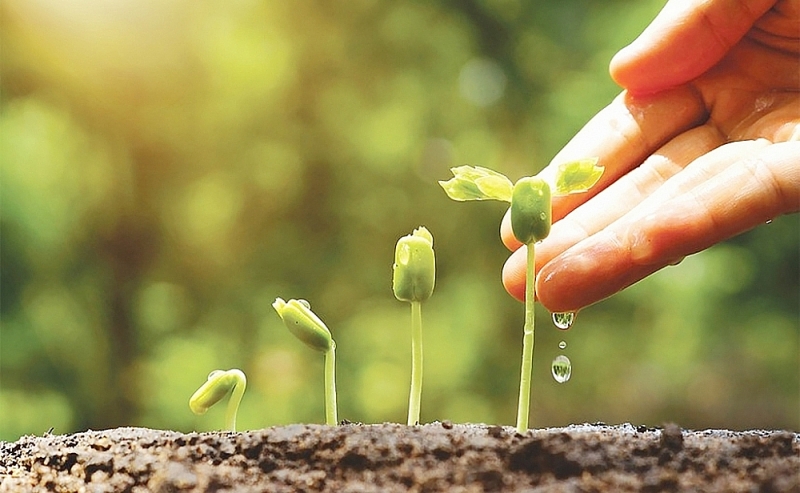Opportunity to recover from green growth
Green growth is a problem for economies in the context that the Covid-19 pandemic has had a negative impact globally. In order to implement this method, capital is always a concern of enterprises.
 |
|
Green growth should be noticed by businesses and proposed implementation plans. Photo: ST |
“Vaccines” for businesses
Talking about green growth with Vietnamese businesses, Mr. Jacques Morisset, Chief Economist of the World Bank (WB) in Vietnam, said that environmental pollution poses a high risk to the competitiveness of exports and attracting FDI from Vietnam. For example, the European Union's green deal and the Border Carbon Regulatory Mechanism will require exporters to pay depending on carbon emissions. Vietnamese enterprises are vulnerable to the mechanisms because of their high emissions used in production (carbon intensity).
According to the Ministry of Planning and Investment, in the period from 2011 to 2020, the proportion of industrial enterprises with awareness of cleaner production has increased from 28% in 2010 to 46.9% in 2020; green credit outstanding balance reached nearly VND238 trillion in 2018 (up 235% compared to 2015); solutions to reduce greenhouse gas emissions were widely deployed in all fields, greenhouse gas emissions in energy activities decreased by 12.9% compared to the normal development option.
Therefore, this agency is submitting to the Government for approval the "National strategy on green growth for the 2021-2030 period, with a vision to 2050", with "dual goals" of both ensuring green growth and promoting growth cover.
In the context of the Covid-19 pandemic, according to experts, green and sustainable growth will be a "vaccine" for businesses to protect themselves, help them stand firmer and find opportunities to escape difficulties. Even "green production" creates opportunities for businesses to enlist the support of management agencies for businesses. Therefore, many businesses have applied solutions to save energy and protect the environment.
For example, energy-saving windows, heat-reflecting paint, LED lighting systems instead of fluorescent lamps, photoelectric sensors, and improved wastewater treatment processes for reuse, etc.
For example, at Vinamilk, specific strategies on environmental protection and sustainable development have helped the company improve its export capabilities and exploit potential markets such as China, Korea, and Singapore, as well as develop new markets in regions such as Africa. The value of Vinamilk's brand has also increased to US$2.4 billion after a challenging year in 2020.
Century Yarn Joint Stock Company has also invested heavily and implemented green projects for the purpose of building and developing towards green growth. In which, the project of producing recycled yarn has been implemented since 2016. By 2020, recycled yarn accounted for 44.7% of the company's total revenue, up 9.7% compared to 2019. According to Century Yarn, through the production of recycled fibers, the company has reused over 2 billion plastic bottles, contributing to protecting the ocean from plastic waste, which is one of the main environmental problems.
TNG Investment and Trading Joint Stock Company has also demonstrated a high level of environmental compliance, such as building wastewater treatment systems at all factories, conducting periodic environmental testing, implementing measures to plant trees, limit greenhouse waste; materials used for production must be safe for the environment and users, the supplier evaluation process includes environmental assessments and interviews.
Credit must also be green
According to the survey results of Nielsen Vietnam Company, Vietnamese consumers are increasingly interested in "green" and "clean" issues, they are willing to pay more for brands with "green" commitments”.
Similarly, market research company Kantar said that in the context of the Covid-19 pandemic and social distancing, consumer needs and behaviors have also changed towards a stable and sustainable lifestyle, being good for health. This shows the importance as well as the right direction of businesses if they want to develop in the long term.
However, for many businesses, investing in green production still faces many difficulties, especially in terms of capital. The report of the Credit Department for Economic Sectors (SBV) shows that, by the end of the first quarter of 2021, outstanding credit for green projects is nearly VND335 trillion, accounting for 3.6% of the total outstanding loans of the whole economy, increasing by 0.46% compared to 2020. In which, green credit mainly focused on green agriculture, accounting for more than 39% of total outstanding loans of green credit; renewable energy, clean energy accounted for 37%. But the implementation of providing capital for businesses to develop green growth and protect the environment still needs to be more drastic.
Understanding this, many banks have launched programs to provide green credit in a timely manner. In May 2021, the Joint Stock Commercial Bank for Investment and Development of Vietnam (BIDV) and the French Development Agency (AFD) signed the SUNREF Green Credit Line Credit Agreement to support businesses to invest in Vietnam in the field of environmental protection, response to climate change and green growth. AFD has assigned BIDV to implement a number of projects such as the Northern Power Transmission Project worth 40 million euros, the project to support the housing development program for people in the Mekong Delta floodplains worth 25 million euros. Sacombank also offers a credit package of VND2,000 billion, lending up to 70% of investment capital needs for solar power projects for corporate customers in the Southwest, Southeast, South Central and Central Highlands regions with an interest rate from 8.5%/year
In order to increase the efficiency of credit granting for environmental projects, the Green Banking Development Project in Vietnam from 2018 has required banks to gradually increase the proportion of credit for green sectors and fields; promoting technology application along with building environmentally friendly habits for customers. By 2025, 100% of will banks carry out assessments of environmental and social risks in credit granting activities. Apply environmental standards to bank-financed projects. 60% of banks have access to green capital and provide loans for green credit projects.








